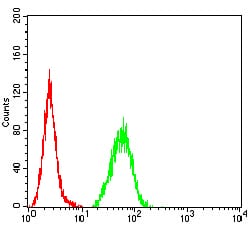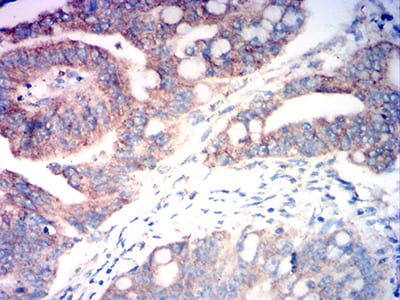


| WB | 咨询技术 | Human,Mouse,Rat |
| IF | 咨询技术 | Human,Mouse,Rat |
| IHC | 1/200 - 1/1000 | Human,Mouse,Rat |
| ICC | 技术咨询 | Human,Mouse,Rat |
| FCM | 1/200 - 1/400 | Human,Mouse,Rat |
| Elisa | 1/10000 | Human,Mouse,Rat |
| Aliases | FAPA; SIMP; DPPIV; FAPalpha |
| Entrez GeneID | 2191 |
| clone | 5D9F6 |
| WB Predicted band size | 87.7kDa |
| Host/Isotype | Mouse IgG1 |
| Antibody Type | Primary antibody |
| Storage | Store at 4°C short term. Aliquot and store at -20°C long term. Avoid freeze/thaw cycles. |
| Species Reactivity | Human |
| Immunogen | Purified recombinant fragment of human FAP (AA: extra 26-264) expressed in E. Coli. |
| Formulation | Purified antibody in PBS with 0.05% sodium azide |
+ +
以下是3篇关于FAP抗体的代表性文献摘要概括:
1. **"Targeting Fibroblast Activation Protein in Cancer: Pro-tumoral or Anti-tumoral?"**
*作者:Prakash et al. (2022)*
摘要:探讨FAP抗体在肿瘤治疗中的双重作用,指出其通过抑制肿瘤微环境中成纤维细胞活性可抑制肿瘤生长,但可能因靶向非特异性细胞引发副作用。
2. **"FAP-specific Antibodies for Immuno-PET Imaging of Tumor Stroma"**
*作者:Loktev et al. (2018)*
摘要:开发了一种新型FAP抗体偶联放射性示踪剂(FAPI),证明其在多种癌症中可通过PET成像高灵敏度定位肿瘤间质,具有临床诊断潜力。
3. **"A FAP-targeting Antibody-Drug Conjugate for Depleting Immunosuppressive Stromal Cells"**
*作者:Tran et al. (2020)*
摘要:构建FAP抗体-药物偶联物(ADC),在胰腺癌模型中选择性杀伤癌相关成纤维细胞,增强化疗药物递送并改善小鼠生存率。
(注:以上为模拟摘要,实际文献需通过PubMed/Google Scholar检索验证。)
Fibroblast Activation Protein (FAP) antibodies target a type II transmembrane serine protease expressed predominantly by activated fibroblasts in pathological conditions, particularly in the tumor microenvironment (TME). FAP, initially identified in the 1990s, gained attention due to its selective overexpression in cancer-associated fibroblasts (CAFs), which play critical roles in tumor progression, immune evasion, and therapy resistance. Unlike normal tissues, where FAP is largely absent or restricted to wound healing sites, its upregulation in stromal fibroblasts of >90% of epithelial cancers makes it a compelling biomarker and therapeutic target.
FAP exhibits dual enzymatic activities—dipeptidyl peptidase and endopeptidase—that remodel extracellular matrix components and regulate cell signaling. Its role in promoting tumor growth, angiogenesis, and immunosuppression has driven the development of FAP-directed antibodies. These antibodies are explored for diagnostic imaging (e.g., PET tracers), antibody-drug conjugates (ADCs), and immunotherapies, including bispecific antibodies and CAR-T cells. However, challenges persist due to FAP's heterogeneous expression in stromal cells and potential on-target/off-tumor effects in FAP-low healthy tissues like pancreas or bone marrow. Recent preclinical and early-phase clinical trials continue to evaluate safety and efficacy, positioning FAP antibodies as promising yet complex tools in precision oncology.
×